Tim Havenith's Blog, page 2
June 30, 2025
Place names of Calne: Castlefields, Castlefields House, Castlefields Canal and River Park
The earliest mention of Castlefield is in 1552 in the church register[1], which was a common field, however after the enclosures of the early 1800s, 33 acres was converted into a park for Castlefields House.
A 1728 map shows the area of Castlefields to be strips of land, which one field called 'Little Castle Field'. However, by 1828, Henry Alworth Merewether (See Castlefields House) owned most of what was still known as Castlefields, with the Marquis of Lansdowne and the Society of Friends owning small parcels.
At least some of the land was still being used for farming in the 1920s, as a photograph showing freely ranging chickens and a thatched rick at the area of Chaveywell shows[2].
Between the 1960s and 1980s, the northern part of Castlefields was developed as the Curzon Park bulgalow estate.
Castlefields Canal and River Park
The southern area, which includes the canal and the river Marden, has been turned into Castlefields Canal and River Park and has been well managed and improved by Castlefields Canal and River Park association since 2001 when it was still owned by Wiltshire Council[3].
A short history:
In 2000 North Wiltshire District Council established the North Wilts River Route, which leads through and out of Castlefields to Chippenham, a 16 km cycle and pedestrian route
In 2010 there was an archaeological dig by Wiltshire Archaeological and Natural History Society in the park to identify the site of Calne's castle. It was discovered that a fortified tower house was locate din the area (see Castle entry).
In 2011 Hills Homes funded the restoration of the former lock and the replica narrow boat, known as the Jubilee Queen, which was completed in 2012.
In 2012 the area was transferred to Calne Town Council as a community asset for the fee of £1. The same year a ring of trees was planted to celebrate the Diamond Jubilee of Queen Elizabeth II, these surround an inner circle of Scots Pines, which commemorate the Diamond Jubiliee of Queen Victoria in 1897. Upper Castlefields park also contains an outline of Calne castle made of cotoneaster.
January 2013 saw Castlefields become a 2 hectare Fields in Trust site with Queen Elizabeth II fields protection, which protects parks and green spaces throughout the UK in perpetuity.
In 2015, it was agreed that the Section 106 agreement for the Station Meadow development would be used to repair the historic wall, which is a complex project including the removal of trees, demolition and partial removal of some of the wall, along with re-building and stabilisation of the wall.
2016 saw the improvements of sports equipment and fitness trail in the park, initially completed in 2005.
In 2017 came the lovely mosaic for the art festival.
In August 2018 Jubiliee Queen was restored and painted and re-stickered, while in 2019 4000 crocus bulbs were planted by volunteers as part of the Rotary Club's 'End Polio Now' campaign.
 Castlefields House
Castlefields HouseCastlefields House
Castlefields house was built c. 1828 for Henry Alworth Merewether (1780-1864), serjeant-at-law, king's counsel, and Town Clerk for the City of London between 1842 and 1859. In 1835, along with Archibald John Stephens, he wrote his principal work, 'The History of the Boroughs and Municipal Corporations of the United Kingdom'. This three volume work detailed the history from the earliest British Period, through the Roman and Saxon period, to his present time.
For a time, it seems that the house, which sat in a 33 acre piece of land and gardens, may have been known at The Hermitage. Certainly there was an area called The Hermitage on Curzon Street that consisted of a barn, stable, and cart house, as well as a later addition of the Hermitage Cottages, on what was most likely land owned by Stanley Abbey. Perhaps it gained The Hermitage as an informal name due to proximity.
The Grade II listed house is built in Tudor Revival Style and uses crenellation on the porch and cornices, perhaps to make a connection with the romantic idea of how a castle would have looked.
The house became a residential care home between 1983 - 2000 and has since been converted into a seven bedroom, four bathroom holiday rental costing between £700-£1500 per night.
26 Castle Street, a Grade II listed building, was the lodge to Castlefields House. The gate piers for Castlefield House also still exist and mark the entrance to the Castlefield housing estate.
 Castlefields
CastlefieldsCastlefields
Castlefields is a small development of bungalows on land, at one time, held by Castlefields House. They were likely built by George Hazell's firm c. 1962, who had acquired a large part of the Castlefields House estate, with Ron Sutton aquiring the northern part of the estate, the drive of which lead to Curzon Street by the lodge (see also, Curzon Park Estate, Lodge Close)[4].
References:
[1] Marsh, A., 1903. A HISTORY OF THE BOROUGH AND TOWN OF CALNE. 1st ed. London: HAZELL, WATSON AND VINEY, LTD.
[2] Treloar, P. (1999). Calne Revisited. 1st ed. Calne Town Council.
[3] Welcome To CARP. 2019. Welcome To CARP. [ONLINE] Available at: http://www.calne-castlefieldspark.co.uk. [Accessed 10 October 2019].
[4] Calne in Photographs public group | Facebook. 2019. Calne in Photographs public group | Facebook. [ONLINE] Available at: https://www.facebook.com/groups/CalnePhotographs/permalink/474667803123217/. [Accessed 13 October 2019].
May 31, 2025
Place names of Calne: The Gardens
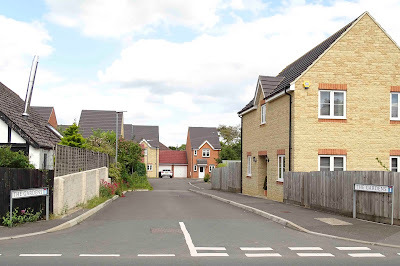 The Gardens, CalneThe Gardens is a name well used for streets that are built upon or next to allotment gardens. Which would make sense with The Gardens, which borders what was a large allotments, these days it is much smaller. However, in this case the name, which was decided in 2013[1], was chosen because this development is quite literally built in the back gardens of four different properties.
The Gardens, CalneThe Gardens is a name well used for streets that are built upon or next to allotment gardens. Which would make sense with The Gardens, which borders what was a large allotments, these days it is much smaller. However, in this case the name, which was decided in 2013[1], was chosen because this development is quite literally built in the back gardens of four different properties.The Gardens, a collection of 2 and 3 bedroom properties, was built by Hannick Homes, a company based in Swindon. After the demolition of a single dwelling on Lickhill Road, ten houses with access were given planning permission in 2007. An additional application was granted in 2012 to allow two additional houses to be built, increasing the development to twelve dwellings[2].
References:
[1] CALNE TOWN COUNCIL TOWN DEVELOPMENT AND PLANNING COMMITTEE, 10 September 2013.
[2] Planning application N/07/00871/FUL
Deputy Mayor Update: May 2025 - Civic Spotlight
This has been a busy month, which began with an invite to Bowood by Dr Lizzie Rogers, the archivist and curator at the house. This invite came off the back of the Priestley 250 work that I took part in during 2024 as a member of the Steering Group, primarily providing services on behalf of Calne Heritage Centre.
This visit, which took place on 1 May 2025, provided an opportunity to see Lizzie's work in providing an exhibit showing the context of Dr Joseph Priestley's experiments with various gases, including oxygen, which came to fruition at Bowood in August 1774 when he discovered "dephlogisticated air". Antoine Lavoisier disproved the phlogiston theory and renamed the gas oxygen, recognizing its role in combustion and respiration. The visit also led to Calne Men's Shed being enlisted to provide a stand, which I noticed was missing from the setup - many thanks to Lizzie for accommodating us and for providing the Men's Shed with the additional work.
 Sue Peskett and John Boaler, two of Calne's wonderful community volunteers,
Sue Peskett and John Boaler, two of Calne's wonderful community volunteers,with myself and Dr Lizzie Rogers to the right.
 Priestley exhibit at Bowood House, featuring
Priestley exhibit at Bowood House, featuring wooden stand provided by Calne Men's Shed.
As seen in Lizzie's exhibit, Priestley's setup included:An earthenware trough for holding water, along with thin flat stones placed under the surface.Cylindrical jars and a tall beer glass, which he used in experiments involving mice.A phial with a perforated cork and a bent glass tube, secured with cement.Pots or dishes to contain vessels of air.A receiver, constructed with perforated tin plates, a wooden frame, and paper lining, designed to allow airflow.Other key items included a wire stand, glass funnel, cylindrical glass vessel, waxed candle, and wire, highlighting how simple objects played a role in complex discoveries.
On 12 May 2025, at the Annual Meeting, I was elected as Deputy Mayor to Ian Thorn for the 2025-26 term—a role I am truly honoured to undertake. I look forward to working hard for the town and serving its people to the best of my ability.

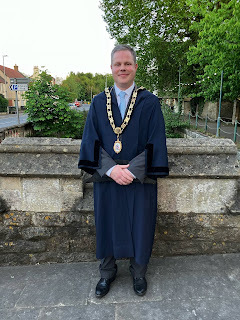
On the 17 May, I took part in a meeting between the Calne Twinning group and their counterparts from Caln Township, Pennsylvania. This meeting reinvigorated relations and provided an opportunity to look towards the future as both groups pass over leadership.
 Photo Credit: Derek Liversidge.
Photo Credit: Derek Liversidge.I was also invited to the 10th Anniversary Classic Car and Bike Run on 18 May. This event hosted by The Rotary Club of Chippenham raised over £4,500 for the The RISE Trust and local Rotary Charities.
 Robing Ceremony for the New Mayor of Malmesbury, Councillor Stephen James
Robing Ceremony for the New Mayor of Malmesbury, Councillor Stephen JamesFinally, I represented Calne on behalf of the Town Mayor at the Malmesbury Mayor Inauguration and Robing. This type of engagement is helpful in strengthening relationships and also seeing how things are done differently in other towns. I discovered that Malmesbury has a thriving twinning group and may be able to provide some guidance to the new Calne twinning group. I have now passed on the contact details to Calne's group to make contact, if they so wish.
If you would like the Town Mayor, Deputy Town Mayor or a Town Councillor to attend your event please get in touch with us at calne@calne.gov.uk
Civic Spotlight: May 2025
This has been a busy month, which began with an invite to Bowood by Dr Lizzie Rogers, the archivist and curator at the house. This invite came off the back of the Priestley 250 work that I took part in during 2024 as a member of the Steering Group, primarily providing services on behalf of Calne Heritage Centre.
This visit, which took place on 1 May 2025, provided an opportunity to see Lizzie's work in providing an exhibit showing the context of Dr Joseph Priestley's experiments with various gases, including oxygen, which came to fruition at Bowood in August 1774 when he discovered "dephlogisticated air". Antoine Lavoisier disproved the phlogiston theory and renamed the gas oxygen, recognizing its role in combustion and respiration. The visit also led to Calne Men's Shed being enlisted to provide a stand, which I noticed was missing from the setup - many thanks to Lizzie for accommodating us and for providing the Men's Shed with the additional work.
 Sue Peskett and John Boaler, two of Calne's wonderful community volunteers,
Sue Peskett and John Boaler, two of Calne's wonderful community volunteers,with myself and Dr Lizzie Rogers to the right.
 Priestley exhibit at Bowood House.
Priestley exhibit at Bowood House.As seen in Lizzie's exhibit, Priestley's setup included:
An earthenware trough for holding water, along with thin flat stones placed under the surface.Cylindrical jars and a tall beer glass, which he used in experiments involving mice.A phial with a perforated cork and a bent glass tube, secured with cement.Pots or dishes to contain vessels of air.A receiver, constructed with perforated tin plates, a wooden frame, and paper lining, designed to allow airflow.Other key items included a wire stand, glass funnel, cylindrical glass vessel, waxed candle, and wire, highlighting how simple objects played a role in complex discoveries.On 12 May 2025, at the Annual Meeting, I was elected as Deputy Mayor to Ian Thorn for the 2025-26 term—a role I am truly honoured to undertake. I look forward to working hard for the town and serving its people to the best of my ability.


On the 17 May, I took part in a meeting between the Calne Twinning group and their counterparts from Caln Township, Pennsylvania. This meeting reinvigorated relations and provided an opportunity to look towards the future as both groups pass over leadership.
 Photo Credit: Derek Liversidge.
Photo Credit: Derek Liversidge.I was also invited to the 10th Anniversary Classic Car and Bike Run on 18 May. This event hosted by The Rotary Club of Chippenham raised over £4,500 for the The RISE Trust and local Rotary Charities.
 Robing Ceremony for the New Mayor of Malmesbury, Councillor Stephen James
Robing Ceremony for the New Mayor of Malmesbury, Councillor Stephen JamesFinally, I represented Calne on behalf of the Town Mayor at the Malmesbury Mayor Inauguration and Robing. This type of engagement is helpful in strengthening relationships and also seeing how things are done differently in other towns. I discovered that Malmesbury has a thriving twinning group and may be able to provide some guidance to the new Calne twinning group. I have now passed on the contact details to Calne's group to make contact, if they so wish.
If you would like the Town Mayor, Deputy Town Mayor or a Town Councillor to attend your event please get in touch with us at calne@calne.gov.uk
May 5, 2025
𝐎𝐔𝐓 𝐍𝐎𝐖 Calne Place Names - 𝐒𝐄𝐂𝐎𝐍𝐃 𝐄𝐃𝐈𝐓𝐈𝐎𝐍
Kindle Edition: https://amzn.to/4iQcu8V Paperback: https://amzn.to/44WoMJn This book delves into the fascinating origins and evolution of over 400 street names, local places, and modern developments, revealing the surprising layers of history beneath this ancient market town. From Saxon and Anglo-Norman roots to the legacy of influential figures and the ever-expanding town boundaries, Calne's place names offer a unique journey through time. More than just a dictionary of names, this book weaves together historical records, local knowledge, and captivating anecdotes to bring Calne's past to life. Discover the intriguing connections and answer questions such as:
 Uncover the mystery of where Tori Amos filmed her haunting "Jackie's Strength" music video.
Uncover the mystery of where Tori Amos filmed her haunting "Jackie's Strength" music video.  Delve into Calne's surprising connection to the very air we breathe - the discovery of Oxygen.
Delve into Calne's surprising connection to the very air we breathe - the discovery of Oxygen.  Trace the journey of the first-class English cricketer who traded the pitch for the pulpit, becoming a Canon and saviour of St. Mary's Church.
Trace the journey of the first-class English cricketer who traded the pitch for the pulpit, becoming a Canon and saviour of St. Mary's Church.  Journey back to a time when Calne's streets echoed with the snorts and grunts of "Hog Street" and "Piggy Hill," revealing the town's deep-rooted bacon industry.
Journey back to a time when Calne's streets echoed with the snorts and grunts of "Hog Street" and "Piggy Hill," revealing the town's deep-rooted bacon industry.  What are the enigmatic "Calne Fates" recently unearthed from the shadows of St. Mary's School, and what secrets do they hold? Fully revised and updated, this edition expands upon the last by including numerous previously lost place names, reflecting the significant changes Calne has undergone in the past five years, and offering a glimpse into the town's proposed future developments. This book is a tribute to the people, events, and industries that have shaped Calne, from its earliest days to its present-day vibrancy. It's a celebration of community, memory, and the enduring power of place.Also available soon at Calne Heritage Centre
What are the enigmatic "Calne Fates" recently unearthed from the shadows of St. Mary's School, and what secrets do they hold? Fully revised and updated, this edition expands upon the last by including numerous previously lost place names, reflecting the significant changes Calne has undergone in the past five years, and offering a glimpse into the town's proposed future developments. This book is a tribute to the people, events, and industries that have shaped Calne, from its earliest days to its present-day vibrancy. It's a celebration of community, memory, and the enduring power of place.Also available soon at Calne Heritage CentreMay 1, 2025
Calne Curiosities: Exploring Calne's History and How We Say the Name
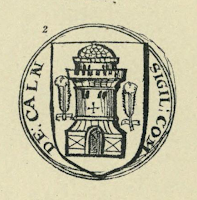 Arms of the Guild and Stewards of Calne,
Arms of the Guild and Stewards of Calne, from The Visitation of Wiltshire 1623.Having lived in Wiltshire for close to two decades, I'vecome to appreciate the often-surprising ways local place names are pronounced.Let's explore a fundamental part of Calne's fabric: the town's name itself –its ancient roots, its historical spellings, and the ongoing discussion aroundhow we say it today.
Our earliest written record of Calne dates to the 10thcentury, specifically the Will of the Saxon King Edred (c. 923 – 955), grandsonof Alfred the Great. In this document from 955, King Edred bequeathed theestates of Downton, Damerham, and Calne to the Old Minster at Winchester,indicating Calne's royal ownership and significance even in those early times.
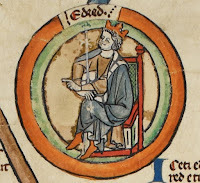 Saxon King EdredYet, the name "Calne" is even older than thisfirst written mention. Linguistic analysis suggests a pre-English origin, with ADictionary of British Place Names confirming its antiquity. One leadingtheory, supported by the linguist Ekblom (1917), points to a Celtic origin,potentially linking it to "Colne" in Lancashire, a name that itselfwas once recorded as "Calna" – a spelling also used for Calne in1091. The prevailing explanation connects "Calne" to the river of thesame name, derived from the Celtic "Col-aun," meaning "meetingor current of waters," likely referring to the confluence of streamsfeeding the River Marden and Abberd Brook in the town's heart. Intriguingly,the Norman scribes of the Domesday Book in 1086 referred to the town as"Cauna" or "Caune," further solidifying the earlyestablishment of the name.
Saxon King EdredYet, the name "Calne" is even older than thisfirst written mention. Linguistic analysis suggests a pre-English origin, with ADictionary of British Place Names confirming its antiquity. One leadingtheory, supported by the linguist Ekblom (1917), points to a Celtic origin,potentially linking it to "Colne" in Lancashire, a name that itselfwas once recorded as "Calna" – a spelling also used for Calne in1091. The prevailing explanation connects "Calne" to the river of thesame name, derived from the Celtic "Col-aun," meaning "meetingor current of waters," likely referring to the confluence of streamsfeeding the River Marden and Abberd Brook in the town's heart. Intriguingly,the Norman scribes of the Domesday Book in 1086 referred to the town as"Cauna" or "Caune," further solidifying the earlyestablishment of the name.The Evolving Written Form of Calne
Like many place names (and indeed, surnames), the spellingof Calne has been far from static over the centuries. Within Wiltshire alone,we see examples like Cherhill (once "Ciriel" and"Chirieli") and Yatesbury (formerly "Getesbir") undergoingsignificant transformations in their written forms. Even places like East andWest Kennett have seen a return to older spellings.
Drawing upon The Place Names of Wiltshire by Gover,Mawer, and Stenton, we can trace at least ten documented variations in thespelling of Calne since its first written appearance. It's crucial to rememberthat this record only captures spellings that were written down, survived thepassage of time, and have since been discovered; the spoken variations may havebeen even more numerous.
Here is a timeline of the documented spellings of Calne:
Variant
Earliest Date
Source
Calne
955
Cartularium Saxonicum, ed. W. de Gray Birch
æt Cálne
978
Anglo Saxon Chronicle
et Calnæ
997
Codex Diplomaticus Aevi Saxonici, ed. J. M. Kemble
Cauna, Caune
1086
Domesday Book
Calna
1091
Vetus registrum Sarisberiense alias dictum Registrum S. Osmundi, Episcopi
Kalne
1158
Report on Manuscripts in Various Collections (Historical Manuscripts Commission)
Calne
1198
Placitorum Abbrevatio (Record Commission)
Kaune
1236
Calendar of Close Rolls Preserved in the Public Record Office
Calle al. Calne
1460
Calendar of Patent Rolls (Public Record Office)
Cawne
1556
Feet of Fines, 1273-1760 (unpublished) in the Public Record Office
Cawen
t. Eliz (1558-1603)
Calendar of Proceedings in Chancery in the Reign of Queen Elizabeth, ed. J. Bayley
Caln
1588
Wiltshire Notes and Queries
Cawlne
1588
MS Collections of John Sadler in Wiltshire Museum at Devizes
Cane
1672
Admission to the College of St John the Evangelist
Caln and Calne
1753
Britannia Depicta road atlas
This historical overview reveals a fascinating trend: while the spelling ofCalne has indeed fluctuated, there's a strong tendency to revert to the"Calne" form. Considering its over 1000 years of written history, thecore spelling has shown remarkable resilience. The 16th century stands out witha cluster of variations like "Cawne," "Cawen,""Caln," and "Cawlne," even appearing concurrently. Thesubsequent standardization of English spelling likely cemented"Calne" as the dominant written form, although it's intriguing tonote that our Town Twin in Pennsylvania still uses the "Caln"variant, perhaps echoing one of these earlier spellings.
An Ancient Settlement and a Site of Significance
The long history suggested by the name's origins andspelling is further confirmed by archaeological evidence. Excavations inCastlefields in 2010 unearthed artifacts from the Iron Age, Roman, Saxon, andMedieval periods, firmly establishing Calne as a very ancient settlement. Itshistorical significance is also highlighted by the Anglo-Saxon Chronicle'srecord of a crucial meeting of the Witan, the King's chief advisors, held inCalne in 978.
From Wool to Bacon: Shaping Calne's Identity
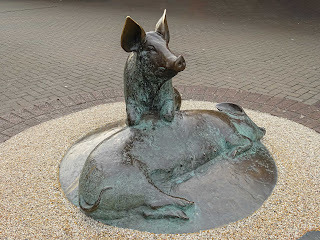 'Two Pigs' sculpture in Calne: A tribute to the town's historic bacon industry.
'Two Pigs' sculpture in Calne: A tribute to the town's historic bacon industry.Over the centuries, Calne's fortunes have been shaped byvarious industries and events. From the 12th to the 19th centuries, the woollenindustry brought considerable prosperity, leaving its mark on many of thetown's older buildings around The Green. However, the decline of this industryin the early 1800s brought hardship. An unexpected resurgence came with therise of the Harris family and their revolutionary bacon curing methods, establishedby the purchase of weak Irish pigs that would not survive their journey toLondon from their overnight stop Black Dog Hill. The Harris business grew todominate Calne both economically and physically in the 20th century,unfortunately leading to the demolition of some historic buildings for factoryexpansion. Other notable industries included the Maundrell Foundry, whichsupported the Harris operations.
Notable Figures and Lasting Legacies
Calne has also been associated with prominent figuresthroughout history. The 5th Marquess of Lansdowne of nearby Bowood House playeda significant role in national politics, while middle-distance runner WalterGoodall George, also from Calne, held the world mile record for over threedecades. The town was also the rectory of Edmund Rich, who later becameArchbishop of Canterbury and was canonized. Briefly, John Pym, a key figureleading up to the English Civil War, served as the town's MP.
Nearby Bowood House was a hub of scientific discovery, with Jan Ingenhousz,polymath and discoverer of photosynthesis a friend and guest, along with JosephPriestley's identification of oxygen taking place at the Grade I listedGeorgian country house surrounded by the landscaped parkland designed byCapability Brown . Priestley also conducted experiments at the Old Vicarage inMill Street, Calne, where he lived for a time. The impressive St. Mary's Churchstands as a legacy of the medieval wealth generated by the woollen trade.
Connecting with the World: Canal, Railway, andRegeneration
Calne's connections to the wider world evolved with theextension of the Wilts and Berks Canal in 1802 and the arrival of the CalneBranch Railway in 1863. While the canal eventually closed, the railway too fellvictim to the Beeching cuts in 1965. More recently, the closure of C&THarris in 1982 and the subsequent demolition of their factory buildings havepaved the way for the regeneration of the town, particularly along the RiverMarden and Beach Terrace.
The Ongoing Question of Pronunciation
 Given this rich and evolving history, and as the varyinghistorical spellings subtly suggest, the pronunciation of Calne remains a pointof local interest. Research into written sources reveals several possibilities: Canon Jackson, in his 1888 history, noted the contemporary pronunciation as "Calne (Carn)". The Pronunciation of 10,000 Proper Names (1909) suggested "kôn," which corresponds with a pronunciation of ‘Kawn’. The Place-Names of Wiltshire (1939) recorded the local pronunciation phonetically as "Kɑːn, vulgo (commonly known as) Kan," aligning with 'Kahn'.
Given this rich and evolving history, and as the varyinghistorical spellings subtly suggest, the pronunciation of Calne remains a pointof local interest. Research into written sources reveals several possibilities: Canon Jackson, in his 1888 history, noted the contemporary pronunciation as "Calne (Carn)". The Pronunciation of 10,000 Proper Names (1909) suggested "kôn," which corresponds with a pronunciation of ‘Kawn’. The Place-Names of Wiltshire (1939) recorded the local pronunciation phonetically as "Kɑːn, vulgo (commonly known as) Kan," aligning with 'Kahn'.My own experience living here suggests the most commonpronunciations are "Karn" and "Caln", with the emphasis onthe ‘l’, with "Calen" being less frequent in the UK but used by ourfriends in Caln Township. It's fascinating to observe how attached people areto their preferred pronunciation, often citing long family histories in thearea.
Whatever your perspective, it can be seen that from its royal connections inSaxon times and its significance as a meeting place of the Witan, through theprosperity of the wool trade and the transformative era of the Harris baconindustry, Calne has continually adapted and evolved.
The very name of the town, with its ancient Celtic roots and its variedspellings across centuries, serves as a tangible link to this enduring past.
Today, as residents and newcomers alike navigate the subtle nuances of itspronunciation, they become part of this ongoing story. Calne's identity is notfixed but rather a tapestry woven from its ancient heritage, its periods ofindustry and innovation, and the collective memory of its people – a town thatrespects its deep roots while embracing the present.
In the end, perhaps the most important aspect is mutual understanding. While wemight all have our preferred way of saying "Calne," the fact that werecognize the town being referred to speaks to the dynamic and accommodatingnature of language and of the wonderful people that live in this historic town.
April 30, 2025
Place names of Calne: Off Stokes Croft (Chissell Brook, Ladydown, Lid Brook, The Were
 Ladydown
LadydownIn c. 2002-2003, GreenSquare Homes built around 54 properties off Stokes Croft. The roads for these new properties were named for water courses in Wiltshire, all of which join one of the two River Avons in Wiltshire:
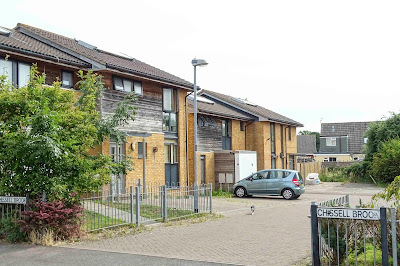 Chissell BrookChissell Brook a short stream near Kellaways joining the Bristol Avon at the bridge next to the Maud Heath sundial.
Chissell BrookChissell Brook a short stream near Kellaways joining the Bristol Avon at the bridge next to the Maud Heath sundial.Ladydown is an area of Trowbridge that the River Biss runs through. It is an old farming area reached via a road that crosses an island, which itself is home to Ladydown watermill. The River Biss joins the Bristol Avon in Widbrook Wood.
Lid Brook covers a large area between Colerne and Ditteridge and drains into the ByBrook near Drewetts Mill House. The ByBrook joins the Bristol Avon at Bathford.
The Were, a tributary and likely origin for the first part of the name of Warminster. Meaning 'to wander' The Were runs through Warminster and the Lake Pleasure Grounds, where it is also called Swan River. It joins the River Wylye in Warminster, which joins the River Nadder at Wilton and finally, as part of the Salisbury Avon, drains to sea at Christchurch.
Place names of Calne: DeFroscia Close
The name was suggested by Cllr Robert Merrick in 2018 while Deputy Mayor, and is to recognise the importance that Tom DeFroscia had in forging the connection between Calne and Caln, Pennsylvania. Tom, who sadly passed on February 13 2017, dedicated his life to Caln and its history and along with being an integral part of the Calne-Caln Twinning Society, he was a member of Caln TWP, Historic Commissioners and Old Caln Historical Society. In July 2019, Hills Homes welcomed Patty DeFroscia, who unveiled the new street name in honour of her husband during a Twinning visit, which serves as an extension of the High Penn Park development.
April 13, 2025
𝐂𝐚𝐥𝐧𝐞 𝐆𝐫𝐞𝐞𝐧 𝐓𝐡𝐫𝐞𝐚𝐝 𝐓𝐫𝐞𝐞 𝐏𝐥𝐚𝐧𝐭𝐢𝐧𝐠
 With Calne Town Council's Amenities, Conservation & Sustainability Manager, Councillor Celia Stevens and I worked with Caitlin at Wiltshire Council's Grant Application and Planting Support (GAPS) team apply for funding to plant trees and hedgerows.
With Calne Town Council's Amenities, Conservation & Sustainability Manager, Councillor Celia Stevens and I worked with Caitlin at Wiltshire Council's Grant Application and Planting Support (GAPS) team apply for funding to plant trees and hedgerows.This was an exhaustive project taking place over many months including desktop surveys and creating location maps, along with onsite visits throughout Calne.
I am pleased to report that we have been successful in our grant application for substantial tree and hedgerow planting across Calne, which will result in close to 70 trees being planted at various locations in Calne and around 250 metres of hedgerow at Beversbrook Sports Facility.
The total fund which covers the initial purchase and planting of the trees as well as 15 years of future maintenance came to over £40,000.
Many thanks to all involved in this project.
March 31, 2025
Place Names of Calne: Victoria Terrace
 Victoria Terrace is named for Alexandrina Victoria (24 May 1819 – 22 January 1901). Queen of the United Kingdom of Great Britain and Ireland from 20 June 1837 until her death and Empress of India from 1 May 1876. Her reign lasted for 63 years, 216 days, second only to our current monarch, Queen Elizabeth II.
Victoria Terrace is named for Alexandrina Victoria (24 May 1819 – 22 January 1901). Queen of the United Kingdom of Great Britain and Ireland from 20 June 1837 until her death and Empress of India from 1 May 1876. Her reign lasted for 63 years, 216 days, second only to our current monarch, Queen Elizabeth II.Queen Victoria reigned during a time of massive expansion for the British Emprire and the people of the Victorian Era were well known for their knowledge and daring in all things engineering, scientific, industrial, and military.
 Providence Row, Victoria Terrace
Providence Row, Victoria TerraceVictoria married her cousin Prince Albert in 1840 and to reinforce the connection of this street name to Queen Victoria, the impressive Albert Villa (1 Victoria Terrace) sits on the corner of North Street and Victoria Terrace, completing the pair.
Victoria Terrace was built mostly by 1885, with one set of terraced housing, Providence Row built in 1870 by Mr. James Cleverley who acquired the land from the estate of George Shadforth Ogilvie. Victoria Terrace continued as a private road, at least until 1890, however it seems that there was resistance from the property owners at the time in passing the street over to the authorities, even when the authorities had paid for improved sewers in 1889[1]. However, in 1890, when they asked the council for a street lamp to be erected, the Clerk took no time in writing to them to advise that as long as the street remained private, the responsibility was theirs, and further to this, the authority was now calling upon the property owners to install a lamp![2] Unfortunately the saga does not appear to continue in the newspapers.
References:
[1]'Victoria Terrace Sewer' Devizes and Wiltshire Gazette, Thursday 18 April 1889 [ONLINE] Available at: https://www.britishnewspaperarchive.c... [Accessed on 1 October 2019]
[2] 'Calne Urban Saniatary Authority and the Infectious Disease (Notification) Act' Devizes and Wiltshire Gazette, Thursday 23 January 1890 [ONLINE] Available at: https://www.britishnewspaperarchive.c... [Accessed on 1 October 2019]



